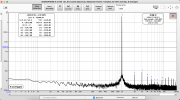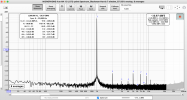01/30/2022 EDIT: I revised this post to show measurements made with the Cosmos in stereo mode. The first set of measurements I posted had the Cosmos in mono mode but rather than using a splitter I was taking 2 channels from the DAC similar to what Archimago did with his Topping D10 in his
Cosmos ADC review. At first glance the difference between mono and stereo seemed to make sense, THD was staying the same and I was seeing an improvement in noise. However, the more I looked in to the difference between mono and stereo the more suspicious I became. In particular when measuring my Focusrite 18i20 2nd gen I was seeing a decrease in noise from -98 dB to -101 dB at 2 V output, given that the Cosmos has substantially higher SNR than the 18i20 a 3 dB increase in the Cosmos SNR as a result of switching from stereo to mono should have resulted in essentially no difference in measured noise, not a 3 dB improvement. I pulled out an XLR splitter and did NOT see the same decrease in noise when going from stereo to mono. From a THD perspective the results are worse with the XLR splitter for almost every DAC I've tested as the input impedance is halved. As a result I plan on using stereo mode as my default for all future measurements, I give up a few dBs of ADC SNR but that will really only come to play for DACs that are really pushing the envelope and I have much more confidence in measurements made this way.
My Cosmos ADC (B grade) arrived this week and I've been re-measuring a bunch of DACs including these DIYINHK DACs. See below for some updated FFTs with the Cosmos. All these DACs used the same power supply that is described in the OP. The FFTs represent the best measured THD+N with the Cosmos in stereo mode.
ES9016, stock I/V, NE5532, 1.938 V (full scale), 3.5 V ADC input setting. -109.1 dB THD, 112.4 dB N, -107.5 dB THD+N.
ES9016, Ian Canada I/V, NJM2114D, 2 V, 3.5 V ADC input setting. -106.1 dB THD, -109.6 dB N, -104.5 dB THD+N.
ES9016, Ian Canada I/V, NJM2114D, 4 V, 6.7 V ADC input setting. -105.4 dB THD, -112.4 dB N, -104.6 dB THD+N.
ES9016, Ian Canada I/V, OPA1612, 2 V, 1.7 V ADC input setting. -122.1 dB THD, -112.4 dB N, -112.0 dB THD+N.
ES9016, Ian Canada I/V, OPA1612, 4 V, 3.5 V ADC input setting. -124.4 dB THD, -115.7 dB N, -115.2 dB THD+N.
ES9038, Ian Canada I/V, NJM2114D, 2 V, 3.5 V ADC input setting. -108.1 dB THD, -108.1 dB N, -105.1 dB THD+N.
ES9038, Ian Canada I/V, NJM2114D, 4 V, 10 V ADC input setting. -99.2 dB THD, -109.9 dB N, -98.9 dB THD+N.
ES9038, Ian Canada I/V, OPA1612, 2 V, 2.7 V ADC input setting. -110.3 dB THD, -108.4 dB N, -106.3 dB THD+N.
ES9038, Ian Canada I/V, OPA1612, 4 V, 3.5 V ADC input setting. -112.0 dB THD, -113.8 dB N, -109.8 dB THD+N.
A few random thoughts on the measurements.
-Stock ES9016 does surprisingly well and is quite low noise
-Cosmos shows some power supply spurs around the fundamental much more clearly than the MOTU
-Seems like the NJM2114D may not like the low input impedance of the Cosmos
-No reason to go with the ES9038 over the ES9016, I am also using the "good" channels of the ES9038, expect inner channels to be worse
-ES9016 + Ian Canada I/V + OPA 1612 is the second best 8+ channel DAC I have measured so far, only surpassed by the Okto DAC8 pro
-Still think that once you add power supplies, I/V stages, op amps, deal with turn on / off pops and add an enclosure the cost is quite high and you are better off with a commercial offering like the MOTU Ultralite Mk5 or Okto DAC8 pro
Michael


